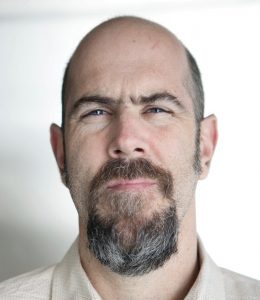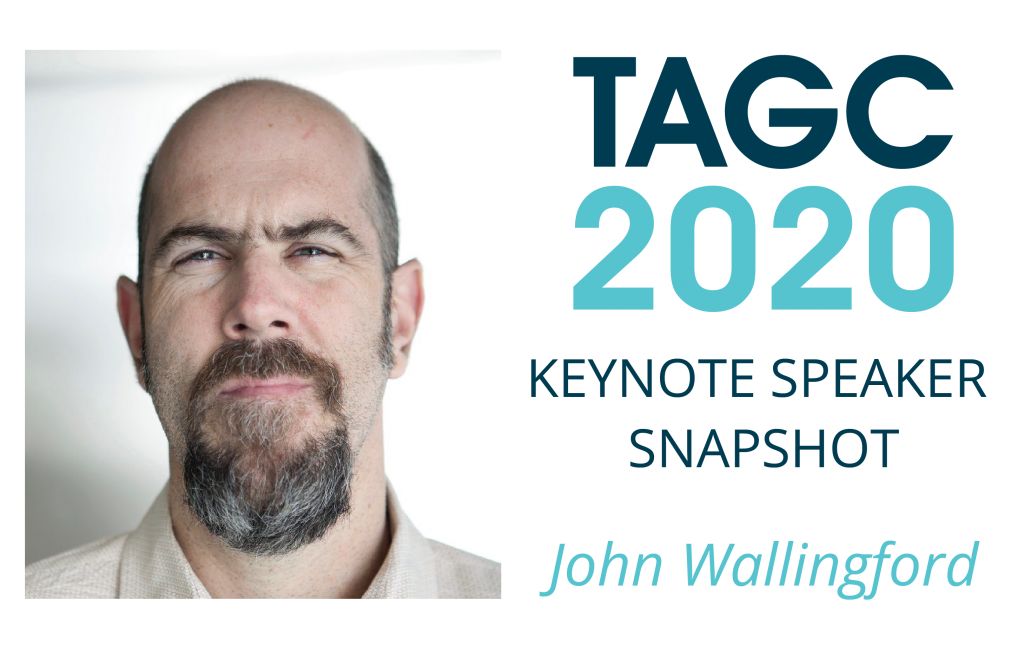Get to know the TAGC 2020 Keynote Speakers through our interview series.

John Wallingford
John Wallingford is a William and Gwyn Shive Endowed Professor of Molecular Biosciences at the University of Texas at Austin. Currently at the Wallingford Lab, he and his team combine in vivo imaging with systems biology to explore the cell biological basis of embryonic development.
What research are you most excited about right now, and why?
I’m excited about the breaking down of barriers. Increasingly, there’s no such thing as cell biology, developmental biology, microbiology, or genetics. These terms are useful for your identity, but they don’t reflect how we do biology now. I’m most excited about where you see big crossover between disciplines; in my lab, that’s predominantly a blurring of the lines between cell and developmental biology.
I love the recent work on how microbiomes are impacting the development of the digestive tracts of vertebrates; many microbes are now known to send chemical signals that influence the development and differentiation of animals. I’m also excited about the interface of physics and developmental biology—a lot of work on tissue morphogenesis is really blurring those lines. And I’m excited about ecologists coming in and asking questions about developmental biology in wild mice as opposed to lab mice. So these things that blur the lines between disciplines are what’s most exciting to me these days.
What do you like about working with Xenopus?
It’s fast and cheap! I’m a data junkie, and one of the great things about Xenopus is you can move very quickly. If you come up with a harebrained scheme, you can put it into action and get an answer in less than a week sometimes. I really enjoy that aspect. You can tear through hypotheses really quickly.
I also love imaging. People say, “Oh, you can’t image in Xenopus, it’s opaque,” but that’s ridiculous. My entire career has been built on imaging Xenopus. You just have to think about what you want to do. If you want to image deep into an intact animal at early stages, no, it doesn’t work that well. But a great thing about amphibians is that you can explant anything. You can put whatever tissue you want directly against the coverglass, and the cells are enormous. That lets you dig into subcellular behaviors as they occur in the embryo, which is what I’m interested in. Xenopus is an outstanding model system for that.
So many model organisms are so well established, it’s not unthinkable to jump from one system to another. My lab mostly uses Xenopus, but about a third of the lab works with mice. We’ve also done work with worms, and we’re in the process of getting Chlamydomonas up and running. The infrastructure for model organisms is so good now that if the tool in your animal isn’t good, just get another animal!
Is there anything about yourself or the field that made you feel like you didn’t belong in science? What would you say to early career scientists struggling with the same feeling?
The biggest hurdles I faced as a young scientist were my own mental health issues, which I dealt with poorly. I avoided therapy then, but I would encourage folks to face those issues squarely—get after them. Everything is hyper stressful and competitive at a level we never imagined when I was coming up. It’s an increasing problem in the world we live in. To early career scientists, I’d say take time for yourself. Take care of yourself first because you’re not good to anyone else if you don’t. That doesn’t mean six weeks of vacation every year, but it does mean taking care of yourself day-to-day.
Something else I tell early career folks is, “Don’t psych yourself out.” Don’t sit there and think of all the reasons it might not work. People sometimes think, “Oh, I want to go into science, but there’s so many reasons it might not work.” It’s important to understand that that’s just the reality of being in your 20s and starting a career. Everything else you could do might come with the same stresses, and there’s no way to predict what’s going to happen when you’re starting your career. When you understand that, it can help you. It might not make it easier, but it may be more comfortable to realize that career uncertainty is not unique to science.
TAGC aims to foster collaboration between communities and disciplines. Can you give an example of a collaboration that really helped your work?
Absolutely. I’ve been collaborative my whole life because I find it easier to work with other people. We have several collaborations with human geneticists. Sequencing is so fast now that the number of disease alleles is skyrocketing, but the number of alleles we know to be causative is not keeping pace. We have a lot of collaborations where human geneticists approached us with novel genes and alleles with unknown functions, and we explore them in model animals.
The biggest collaboration I’ve had has lasted over 12 years with a systems biologist in my department. He has expertise in computational biology, proteomics, and genomics. He thinks on a systems biology level, while I’m a classical genetic mechanism guy. We see the world in completely different ways, and our collaboration has forced me to question the basic assumptions of the field. I have had to explain why my questions are even interesting to someone who is extremely smart but isn’t steeped in the dogma of the field. I think the best collaborations push you out of your comfort zone.
Select Publications from the Wallingford Lab
The 200-year effort to see the embryo
Wallingford JB
Science. 2019 Aug 23;365(6455):758-759. doi: 10.1126/science.aaw7565
We Are All Developmental Biologists
Wallingford JB
Dev Cell. 2019 Jul 22;50(2):132-137. doi: 10.1016/j.devcel.2019.07.006
PCP-dependent transcellular regulation of actomyosin oscillation facilitates convergent extension of vertebrate tissue
Shindo A, Inoue Y, Kinoshita M, Wallingford JB
Dev Biol. 2019 Feb 15;446(2):159-167. doi: 10.1016/j.ydbio.2018.12.017. Epub 2018 Dec 21
A liquid-like organelle at the root of motile ciliopathy
Huizar RL, Lee C, Boulgakov AA, Horani A, Tu F, Marcotte EM, Brody SL, Wallingford JB
Elife. 2018 Dec 18;7. pii: e38497. doi: 10.7554/eLife.38497
Coming to Consensus: A Unifying Model Emerges for Convergent Extension
Huebner RJ, Wallingford JB
Dev Cell. 2018 Aug 20;46(4):389-396. doi: 10.1016/j.devcel.2018.08.003













